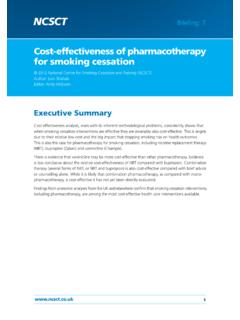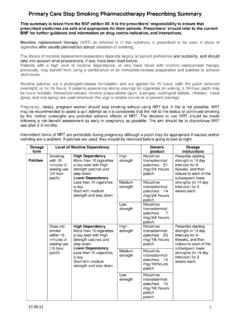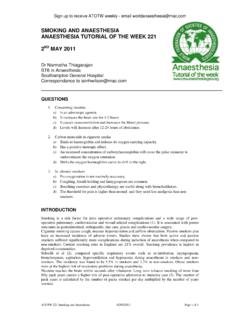Transcription of DATA SHEET - medsafe.govt.nz
1 DATA SHEET 1. PRODUCT NAME CHAMPIX (varenicline, as tartrate) mg and 1 mg film-coated tablets. 2. QUALITATIVE AND QUANTITATIVE COMPOSITION Each film-coated tablet contains mg or 1 mg varenicline (as tartrate). For the full list of excipients, see section 3. PHARMACEUTICAL FORM mg capsular biconvex, white to off-white, film-coated tablet debossed with "Pfizer" on one side and "CHX " on the other side. 1 mg capsular biconvex, light blue film-coated tablet debossed with "Pfizer" on one side and "CHX " on the other side. 4. CLINICAL PARTICULARS Therapeutic Indications CHAMPIX is indicated as an aid to smoking cessation. Dose and Method of Administration Adults Smoking cessation therapies are more likely to succeed for patients who are motivated to stop smoking and who are provided with additional advice and support.
2 The recommended dose of CHAMPIX is 1 mg twice daily following a 1-week titration as follows: Days 1 3: mg one daily Days 4 7: mg twice daily Day 8 End of Treatment: 1 mg twice daily The patient should set a date to stop smoking. CHAMPIX dosing should start 1 2 weeks before this date. Alternatively, a flexible approach to quitting smoking may be adopted. Patients can begin varenicline dosing and then quit smoking between days 8 and 35 of treatment (see section , Clinical Efficacy and Safety, Flexible Quit Date Study). Patients who cannot tolerate adverse effects of varenicline may have the dose lowered temporarily or permanently. Patients should be treated with CHAMPIX for 12 weeks.
3 For patients who have successfully stopped smoking at the end of 12 weeks, an additional course of 12 weeks treatment with CHAMPIX at 1 mg twice daily is recommended to further increase the likelihood of long-term abstinence. A gradual approach to quitting smoking with varenicline should be considered for patients who are not able or willing to quit abruptly. Patients should reduce smoking during the first 12 weeks of treatment and quit by the end of that treatment period. Patients should then continue taking varenicline for an additional 12 weeks for a total of 24 weeks of treatment (see section , Clinical Efficacy and Safety, Gradual Approach to Quitting Smoking Study). Version: pfdchamt10317 Supersedes: pfdchamt10516 Page 1 of 29 Patients who are motivated to quit and who do not succeed in stopping smoking during prior varenicline therapy, or who relapse after treatment, should be encouraged to make another attempt once factors contributing to the failed attempt have been identified and addressed (see section , Clinical Efficacy and Safety, Study in Subjects Re-treated with Varenicline).
4 Dose tapering of CHAMPIX is not required at the end of treatment. Renal Impairment No dosage adjustment is necessary for patients with mild to moderate renal impairment. For patients with severe renal impairment, the recommended dose of CHAMPIX is 1 mg once daily. Dosing should begin at mg once daily for the first 3 days then increased to 1 mg once daily (see section ). Based on insufficient clinical experience with CHAMPIX in patients with end stage renal disease, treatment is not recommended in this patient population (see section , Special Patient Populations). Hepatic Impairment No dosage adjustment is necessary for patients with hepatic impairment (see section ). Elderly No dosage adjustment is necessary for elderly patients (see section ).
5 Because elderly patients are more likely to have decreased renal function, prescribers should consider the renal status of an elderly patient. Paediatric Population Safety and effectiveness of CHAMPIX in paediatric patients have not been established; therefore, CHAMPIX is not recommended for use in patients under 18 years of age (see section ). Method of Administration CHAMPIX tablets should be swallowed whole with water. CHAMPIX can be taken with or without food. Contraindications Hypersensitivity to the active substance or to any of the excipients listed in section Special Warnings and Precautions for Use Effects of Smoking Cessation Physiological changes resulting from smoking cessation, with or without treatment with CHAMPIX, may alter pharmacokinetics or pharmacodynamics of some drugs, for which dosage adjustment may be necessary (examples include theophylline, warfarin and insulin).
6 1As smoking induces CYP1A2, smoking cessation may result in an increase of plasma levels of CYP1A2 substrates. Smoking cessation, with or without pharmacotherapy, has been associated with change in appetite and weight gain. Smoking cessation, with or without pharmacotherapy, has been associated with the exacerbation of underlying psychiatric illness ( depression). Care should be taken with patients with a history of psychiatric illness and patients should be advised accordingly. Version: pfdchamt10317 Supersedes: pfdchamt10516 Page 2 of 29 At the end of treatment, discontinuation of CHAMPIX was associated with an increase in irritability, urge to smoke, depression, and/or insomnia in up to 3% of patients.
7 The prescriber should inform the patient accordingly. Psychiatric Symptoms Serious neuropsychiatric symptoms, including changes in behaviour or thinking, anxiety, psychosis, mood swings, agitation, aggression, depressed mood, suicidal ideation and suicidal behaviour have been reported in patients attempting to quit smoking with CHAMPIX. Patients and their families should be advised that the patient should stop taking CHAMPIX and contact a healthcare professional immediately if such symptoms are observed. Doctors should discuss the efficacy and safety profile of CHAMPIX with patients attempting to quit smoking with CHAMPIX and advise them of the possible emergence of neuropsychiatric symptoms.
8 Patients and their families should be alerted to the need to monitor for the possible emergence of neuropsychiatric symptoms. Patients and their families should be encouraged to report any history of psychiatric illness prior to initiating treatment. A causal association between CHAMPIX and these symptoms has not been established, although association cannot be excluded. Doctors and other healthcare professionals should continue to monitor patients for the development of neuropsychiatric symptoms. On-going follow up of patients with these symptoms should be provided until the symptoms resolve. A large randomized, double-blind, active and placebo-controlled study was conducted to compare the risk of serious neuropsychiatric events in patients with and without a history of psychiatric disorder treated for smoking cessation with varenicline, bupropion, nicotine replacement therapy patch (NRT) or placebo.
9 The primary safety endpoint was a composite of neuropsychiatric adverse events that have been reported in post-marketing experience. The use of varenicline in patients with or without a history of psychiatric disorder was not associated with an increased risk of serious neuropsychiatric adverse events in the composite primary endpoint compared with placebo (see section , Clinical Efficacy and Safety, Neuropsychiatric Safety and section , Special Populations). Analyses of pooled clinical trial data did not show evidence of an increased risk of serious neuropsychiatric events with varenicline compared to placebo. In addition, independent observational studies have not supported an increased risk of serious neuropsychiatric events in patients treated with varenicline compared to patients prescribed nicotine replacement therapy (NRT) or bupropion (see section , Clinical Efficacy and Safety, Neuropsychiatric Safety).
10 Seizures In clinical trials and post-marketing experience there have been reports of seizures in patients with or without a history of seizures, treated with varenicline. Varenicline should be used cautiously in patients with a history of seizures or other conditions that potentially lower the seizure threshold. A causal relationship between these reports and varenicline use has not been established. Hypersensitivity Reactions There have been post-marketing reports of hypersensitivity reactions including angioedema in patients treated with CHAMPIX. Clinical signs included swelling of the face, mouth (tongue, lips and gums), neck (throat and larynx) and extremities. There were rare reports of life-threatening angioedema requiring urgent medical attention due to respiratory compromise.

















